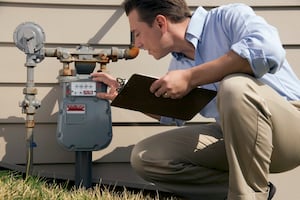 Much of the drinking water infrastructure in the U.S. has been in service for decades and can be a significant source of water loss through leaks, unauthorized consumption (aka, theft), administrative errors, data handling errors, and metering inaccuracies or failure. To help combat public and private water losses, technology companies have stepped up with advanced metering technologies.
Much of the drinking water infrastructure in the U.S. has been in service for decades and can be a significant source of water loss through leaks, unauthorized consumption (aka, theft), administrative errors, data handling errors, and metering inaccuracies or failure. To help combat public and private water losses, technology companies have stepped up with advanced metering technologies.
To stem the tide of water losses and scarcity in their communities, many municipalities across the country have installed innovative smart meter technologies to help capture water loss amounts and gain other benefits. Also, many countries are adopting smart meters for effective water utilization and deal with the increasing water scarcity. There are even government programs that encourage and mandate water-saving smart meters.
What is a Smart Water Meter?
Smart meters provide a powerful management tool with many benefits, including improving a utility’s ability to detect leaks in its distribution system, measure and identify the areas of real water loss, and target specific areas needing repair. Other benefits include performance monitoring, water use segregation for system planning, improved distribution system operations, and better customer service.
IoT is emerging within almost every industry, because of the wide-ranging benefits it offers. The invention of smart water meters that leverage IoT innovation can help considerably with water conservation. Some of the main features of smart water meters include:
- Real-time web-based monitoring
- Advanced data analytics
- Data alerts of the non-revenue water
- Significant water savings
- Flexible billing cycle
Smart Water Meter Advantages
A smart water meter wirelessly communicates with a local or wide area network, enabling remote location monitoring and leak detection. Here are some advantages of a smart water meter over traditional meters.
- Provides real-time web-based metering. This eliminates the need for manual supervision every month in each household.
- Identifies consumption inefficiencies and patterns. Smart meters use an IoT platform that collects data to track water amounts consumed by each consumer. Users can learn about their regular water consumption habits and make informed modifications.
- Deploys two-way communication. A smart water meter facilitates real-time communication between water distributors and consumers. This provides the opportunity for live alerts about leaks, waste, freeze warnings, and more.
- Reduces excess water loss. Reducing water use requires understanding consumption habits and where over-consumption or spilling is occurring.
- Monitors pipeline temperatures. Temperature sensors can also be installed on the pipeline to monitor temperatures and notify consumers of any risks, such as frozen pipes or water stagnation.
- Dynamic water billing. The system remotely tracks each home’s water consumption in real-time and automatically generate consumer bills.
Conserving Water for a Sustainable Future
Supplying water to every corner of the world and calculating water consumption is the biggest challenge today’s water sector faces. Smart efforts to measure and monitor water loss are to provide a valued step forward in this mission.
Once a water system identifies these real and apparent losses through a water loss control program, it can implement controls to reduce them. This can reduce the need for costly upgrades and expansions due to population growth and increased demand. By reducing the amount of water loss, the recovered water can be sold to consumers, generate revenue, and meet water demands.
In some cases, reducing water losses can contribute to a reduction in the need to find additional sources of water in certain parts of the world. As a result, water loss control programs are often the most economical solution to increasing demand for water worldwide.




